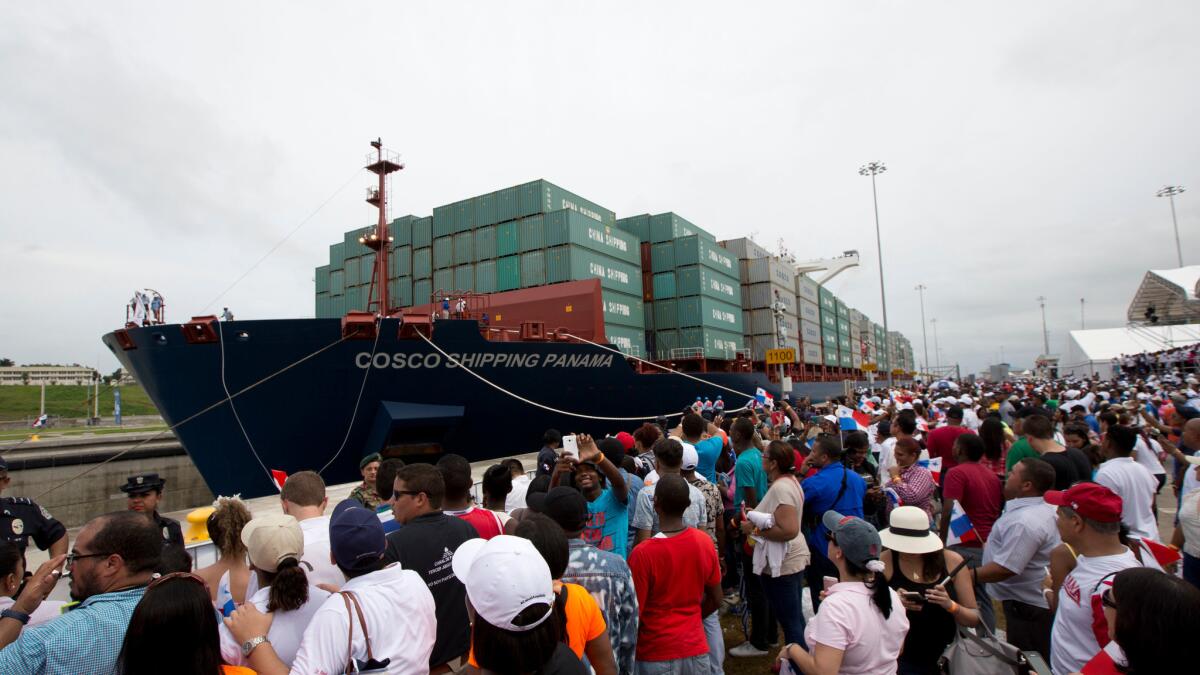A new era in global trade begins, as $5.4-billion Panama Canal expansion opens

Reporting from Bogota, Colombia — A Chinese freighter laden with nearly 9,500 metal cargo containers transited the expanded Panama Canal on Sunday, inaugurating the interoceanic waterway and opening a new era in global trade.
As midmorning clouds dissipated over the 50-mile-long canal, the vessel Cosco Shipping Panama began moving through the new Caribbean-facing Agua Clara locks, part of a $5.4-billion expansion to allow for the passage of bigger ships through the historic waterway. The expansion has been nearly a decade in the making.
Whereas the original canal opened in 1914 to accommodate ships carrying as many as 5,500 cargo containers, the new locks can handle ships ferrying 13,000 such containers. Operators say the expansion was necessary to keep the historic canal competitive in a global freight market.
The expansion ostensibly makes the canal a more efficient option for freight companies shipping goods from China to the Eastern Seaboard, which is the canal’s most important and lucrative commercial route.
But trade experts warn that many U.S. ports are still unprepared to handle the larger ships. That fact, combined with the current softness in global freight traffic, means it may take some time before the traffic justifies the investment.
Before the first ship was lifted from sea level up to Panama’s Gatun Lake, a man-made reservoir that collects water to fill the locks, President Juan Carlos Varela and canal administrator Jorge Luis Quijano welcomed the ship in the Caribbean port city of Colon. Both touted the project’s economic effect and paid tribute to the 40,000 workers who built it.
“What happiness to begin this day and to receive this ship,” Varela told a gathering of thousands canal-side after presenting Cosco executives with a commemorative plaque. Referring to Panama’s multi-century role as a transit route for interoceanic cargo dating to Spanish colonial times, he added: “This is where it all began. It’s been 500 years of history no one can change.”
For centuries, cargo from the Orient or South America’s Pacific coast crossed the Panamanian isthmus by mule, then by train. In 1914, U.S. Army engineers completed the waterway, overcoming disease and significant geological challenges. The canal and the so-called Canal Zone, a five-mile buffer on either side of the waterway, remained U.S. possessions until they were turned over to Panama in 1999.
After decades of expansion proposals that went nowhere, Panama’s then-president, Martin Torrijos, persuaded voters to authorize the expansion in a 2006 referendum, framing it as a means of safeguarding the canal’s commercial importance. Competing canal proposals had been floated in Mexico as well as Nicaragua, raising fears of a freight war.

On June 26th, the Panama Canal will open new expanded locks.
In addition to the Agua Clara locks, a comparable set were built on the Pacific side of the interoceanic canal. The new locks permit the passage of “neo-Panamax” ships measuring 160 feet wide by 1,200 feet long with drafts of 50 feet. The original canal could not accommodate ships that measured more than 106 feet by 965 feet by 39.5 feet.
Although Mexican canal proposals did not advance, Nicaragua in 2014 granted a concession to Chinese businessman Wang Jing to build a $50-billion canal that would compete with Panama’s waterway. That project, however, has yet to start construction because of China’s economic slowdown and Wang’s reported financial difficulties.
Panama Canal Authority officials say they have 170 reservations for cargo ships to transit the canal using the larger locks. Shipping experts say the expansion should add about 15 daily crossings to the 35 to 40 the canal now sees each day.
But transit growth will depend on market conditions — and on ports’ ability to accept larger ships, experts say. Some major U.S. ports, including New York and Tampa, are limited by bridges too low to accommodate the mega-freighters.
“Tampa is prepared for more cargo and we have ample space,” said Evan Cotten, a maritime clerk at the Port of Tampa. “The problem Tampa has is we can only take feeder ships because the largest containers and cruise ships can’t fit under the Sunshine Skyway Bridge” at the mouth of Tampa Bay.
In a statement issued last week, the U.S. Energy Information Administration said the expanded Panama Canal would not appreciably “change crude oil and petroleum product flows” because it is still too small to accommodate the supertankers that petroleum freighters prefer.
The agency noted that although the newer lock systems allow for the transit of larger neo-Panamax tanker vessels with capacities for 400,000 to 600,000 barrels of crude, the “economics of shipping crude oil and petroleum products” call for even larger freighters capable of handling 1 million barrels or more.
Kraul is a special correspondent.
ALSO
7 people stabbed at neo-Nazi event outside state Capitol in Sacramento
Diary of terror: Not a day in April passed without a terror attack
President Trump? Among U.S. allies, Japan may be one of the most anxious about that idea
More to Read
Sign up for Essential California
The most important California stories and recommendations in your inbox every morning.
You may occasionally receive promotional content from the Los Angeles Times.









